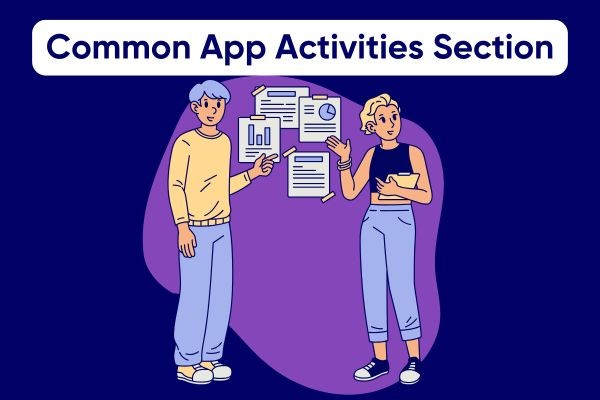The Common App activities section might seem straightforward—but it's one of the most strategic parts of your application. In this blog, we’ll explain what it is, how to use it to your advantage, and how to write descriptions that stand out. Need help with your personal statement too? Check out our college essay examples or how to write a Common App essay.
>>Want us to help you get accepted? Schedule a free strategy call here.<<
What Is the Common App Activities Section?
You know that box labeled "Activities" in your Common App? It matters—a lot more than most students realize. This section is your chance to show colleges what you've done outside of class and who you are beyond grades and test scores.
Quick Overview of What This Section Includes
- Space for up to 10 activities
- Each activity includes a title, role, organization, and 150-character description
- You can categorize your activity from a dropdown list (volunteering, internship, arts, etc.)
Why It Matters More Than You Think
Colleges want to know what you do with your time. This section gives them a snapshot of your passions, commitments, and how you engage with your community. It helps answer the question: What kind of person are you outside the classroom?
What Colleges Are Looking for in This Section
- Consistency: Did you stick with something over time?
- Depth: Were you just a member, or did you take on a leadership role?
- Impact: Did your work affect others in a meaningful way?
- Initiative: Did you start something on your own?
How Colleges Use the Activities Section
Admissions officers at the best schools don’t just glance at your activities list—they use it to understand context. This section helps them evaluate your time management, commitment, and fit for their campus culture.
More importantly, it adds dimension to your narrative. If your essay is about creativity, and your activities include leading a design club and submitting work to contests, that consistency shows depth. On the other hand, if your essay is about resilience but your activities section is blank or scattered, that disconnect might hurt you.
Think of this section as part two of your story: your essay shows who you are, and your activities show how you live it.
Want tips on writing your Common App essay?
How Many Activities Should You List?
You can list up to 10 activities, but that doesn’t mean you should list all 10.
Do You Need to Fill All 10 Slots?
Nope. It’s better to have 5 meaningful activities than 10 random ones you did for a week. Admissions officers can spot filler a mile away.
Quality vs. Quantity: What Works Best?
Go deep. Highlight the stuff that actually mattered to you, where you put in real effort and grew as a person. That’s what colleges care about. A solid activities section can even help you offset a low GPA when applying to college.
What if You Don’t Have 10 Activities?
Totally fine. Focus on explaining the impact and consistency of what you did do. You won’t be penalized for having fewer than 10, especially if you were working, caring for family, or facing barriers to access.
How to Write Strong Activity Descriptions
This is where a lot of students get stuck. You only have 150 characters per description, and it’s tempting to either say too little or cram in a bunch of vague words. Here's how to do it right.
The 150-Character Limit: How to Say More with Less
Don’t waste space on full sentences or fluff. Get straight to the point.
Bad: "As a member of the science club, I helped organize events and attend weekly meetings."
Better: "Organized biweekly STEM workshops; led 3 science fair projects with schoolwide participation."
Action Verbs That Actually Help
Start with a verb that shows what you did:
- Led
- Created
- Designed
- Researched
- Taught
- Launched
- Directed
- Organized
What to Avoid in Descriptions
- Repeating the activity name
- Vague words like "helped" or "worked on"
- Full sentences or personal reflections (save those for your essay)
Formatting Tips for the Activities Section
- Use present tense for current roles, past tense for completed ones
- Don’t capitalize every word—use title case for roles and sentence case for descriptions
- Avoid personal pronouns (no “I”)
- Use digits (“3” instead of “three”) to save space
- Don’t include periods at the end of entries
Do’s and Don’ts for Activity Descriptions
Crafting effective activity descriptions takes strategy. With such limited space, clarity and punch are key.
DO:
- Lead with a powerful verb
- Quantify wherever possible (hours, dollars raised, number of events)
- Show what made you stand out in the role
- Be concise and specific
DON’T:
- Write vague statements like “did tasks as assigned”
- Overuse general terms like “helped” or “participated”
- Waste characters on fluff
- List passive roles that don’t show initiative
Common Mistakes in the Activities Section
You only get 150 characters per activity—so every word matters. Unfortunately, a lot of students miss the mark with vague, unfocused, or redundant entries. Here are common mistakes we see:
1. Using vague language. Phrases like "helped with events" or "worked on projects" tell admissions officers very little. Instead, use specific outcomes: what events, how often, and what was the impact?
2. Writing full sentences. This isn't a personal statement. Keep it brief and direct. No need for "I was responsible for..." or "I participated in..."
3. Overloading with filler. If you only went to one Model UN conference, it might not deserve a full entry unless there’s more context or leadership involved.
4. Repeating other parts of your application. Avoid using this space to rehash your essay or resume. This section should add something new.
5. Ignoring formatting. Poor grammar, inconsistent capitalization, or unclear structure can distract from your accomplishments.
Avoiding these mistakes alone will already make your activities list more competitive than most.
Examples of Common App Activity Entries
Here are several examples that follow Common App best practices—each fits within the 150-character limit and demonstrates clear, quantifiable impact.
Example 1 – Community Service Project
Led monthly food drives; coordinated 20+ volunteers to distribute 1,000+ meals to local families.
Example 2 – Student Council Leadership
Elected Vice President; organized 3 school-wide events and led fundraising for class initiatives.
Example 3 – Artistic or Creative Endeavor
Directed and edited 5 short films; submitted work to national student film competitions.
Example 4 – Part-Time Job or Family Responsibility
Worked 15 hrs/week at retail job; managed inventory, trained 2 new employees.
Example 5 – Athletic Team Commitment
Varsity soccer team captain; led practices, organized team fundraisers, promoted sportsmanship.
Example 6 – STEM or Research Project
Designed and coded math tutoring app; presented to district educators, gained 300+ downloads.
Example 7 – Digital Content Creation
Published blog with 50+ posts on social justice; averaged 1,000 monthly readers; engaged youth via comments.
Example 8 – Educational Outreach
Created digital art workshop; taught 4-week virtual course to middle school students via library partnership.
Before vs. After: Sample Description Makeovers
Final Thoughts: This Section Can Make You Memorable
This is more than just a list. It's a snapshot of what matters to you, what you’ve done with your time, and what kind of community member you might be on campus.
Treat it like a highlight reel. Use strong, clear language. And most of all, be honest.
For official guidance, visit the Common App Help Center for current instructions.
FAQs
1. How many activities should I list in the Common App?
You can list up to 10 activities, but it’s fine to list fewer. Focus on quality over quantity. Admissions officers would rather see 6 meaningful entries than 10 filler ones.
2. What’s the character limit for activity descriptions?
Each description is limited to 150 characters. Make every word count by being concise and results-focused.
3. How should I order my activities?
Put your most impactful, time-intensive, or leadership-based activity first. This is the one that should grab attention right away.
4. Can I group similar activities together?
Yes. If you volunteered at multiple locations doing similar work, combine them and describe your collective impact.
5. What counts as an extracurricular activity?
Anything outside of class—clubs, sports, jobs, caregiving, hobbies, online projects, art, etc.—as long as it shows initiative and effort.
6. Do colleges care if I only have 5 or 6 activities?
No. Colleges value depth over breadth. List only what matters, and focus on showing growth and commitment.
7. Where should I list awards in the Common App?
Use the Honors section for formal awards, but you can mention awards in activity descriptions if they relate directly to your role.
8. Should I use full sentences in my descriptions?
No. Use action-packed phrases with strong verbs. Keep it short, specific, and to the point.
To your success,
Your friends at BeMo


Like our blog? Write for us! >>
Have a question? Ask our admissions experts below and we'll answer your questions!
Comments